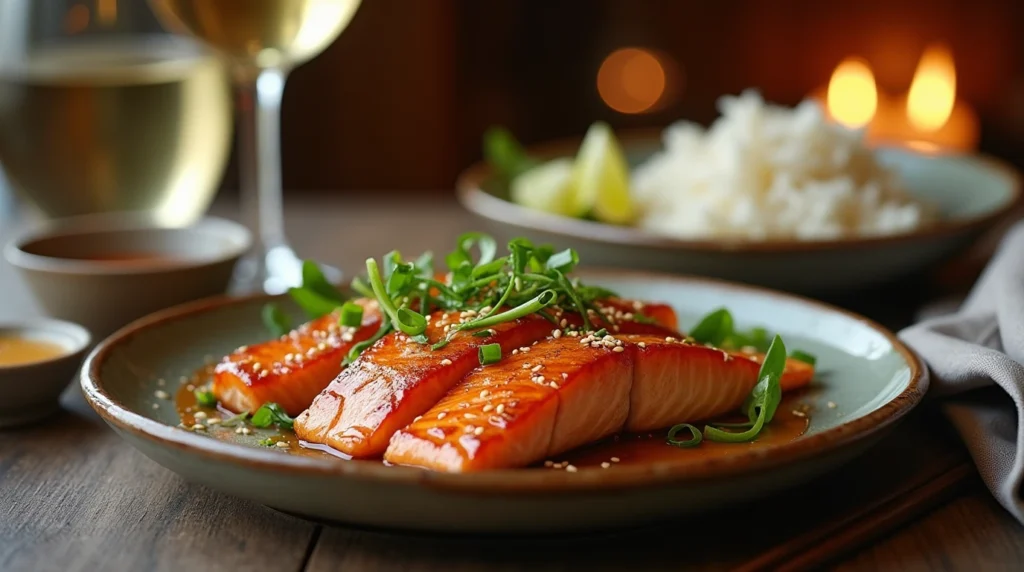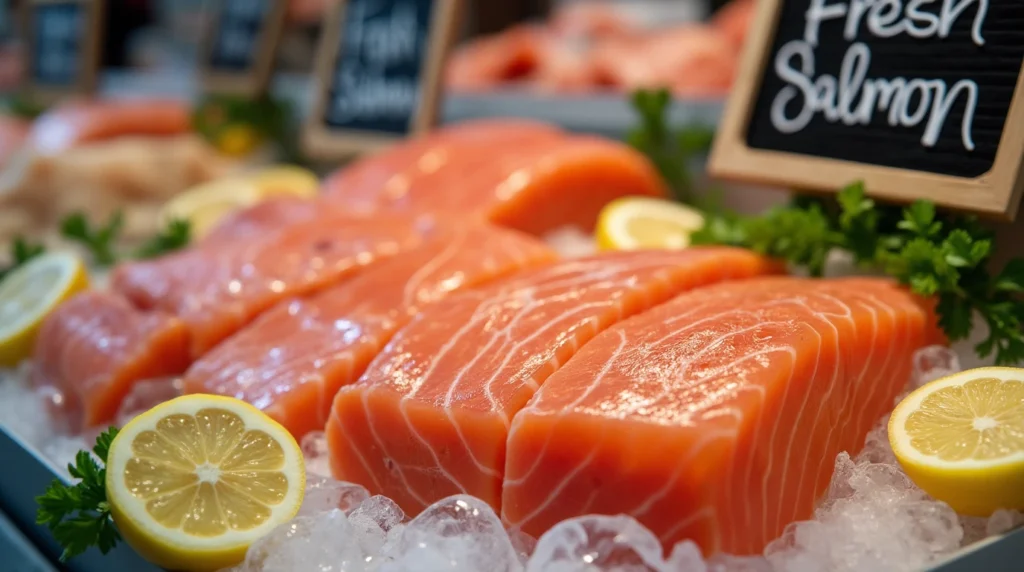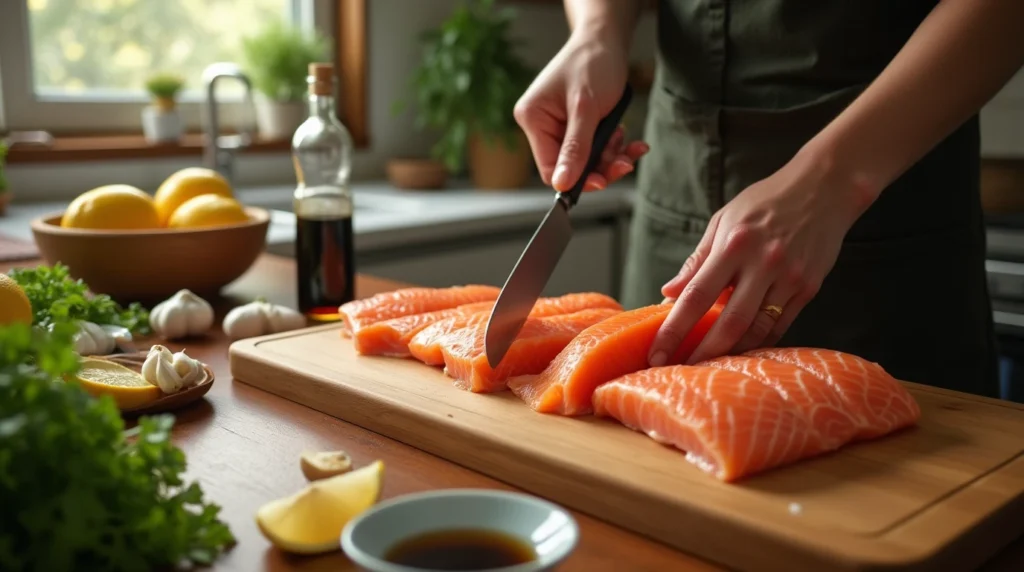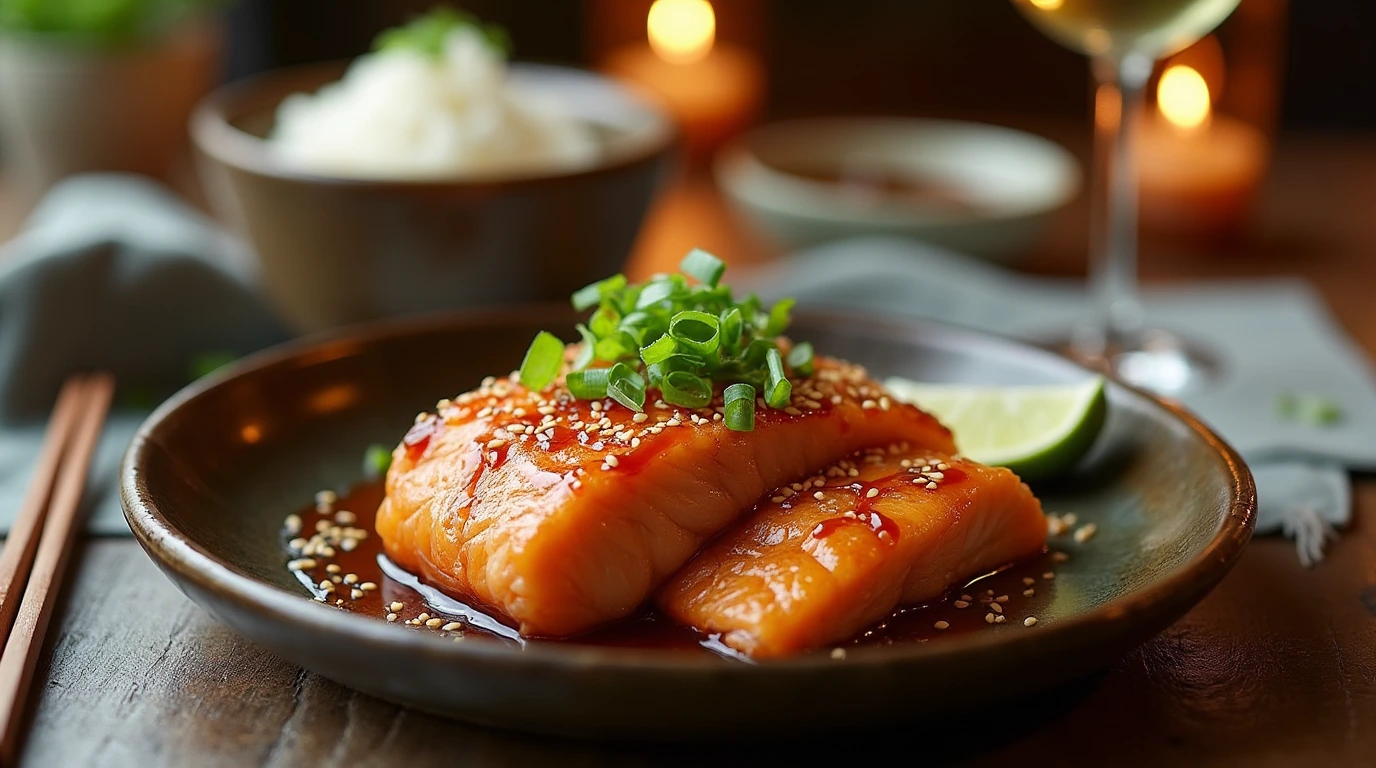Welcome to the world of salmon belly, a cut loved for its rich and buttery texture. This guide will show you how to make a simple yet delicious salmon belly recipe. You’ll learn key techniques to make your cooking as good as a restaurant’s.
From picking the right salmon belly to cooking it perfectly, we’ve got you covered. You’ll learn how to impress your guests with a dish they’ll love.
Discover how to choose the best ingredients, marinate, and serve your salmon belly. You’ll become confident in cooking this premium fish. Let’s start the journey to perfect results in every bite!
What Makes Salmon Belly Special
salmon belly recipe is a standout in seafood, loved for its special taste and texture. It has a lot of fat, which makes it incredibly tender. This makes it a favorite among those who love seafood.
The flavor of salmon belly is unique, with hints of butter and sweetness. It adds a special touch to any dish it’s in.

Texture and Flavor Profile
Salmon belly is known for its high fat content, making it a top choice for cooking. When cooked, it gets a crispy outside and stays soft inside. This mix of textures and flavors is why chefs love it.
Its rich taste makes it great for many dishes, from pasta to sushi. It brings a unique flavor that enhances any meal.
Salmon Belly Recipe
Salmon belly is not just tasty; it’s also very good for you. It’s packed with omega-3 fatty acids, which are good for your heart and brain. Eating salmon belly means you get important proteins, vitamins, and minerals too.
Adding salmon belly to your meals is a great way to enjoy tasty food while also taking care of your health. It’s a win-win for your taste buds and body.
Choosing Quality Salmon Belly
When picking the best salmon belly, it’s key to know the difference between wild-caught and farmed salmon. Wild-caught salmon has better texture and taste, making it a favorite among chefs and home cooks. It also has more omega-3s, which are good for your health.
Farmed salmon is cheaper but still a good choice when wild-caught is not available.

Wild-Caught vs. Farmed Salmon
Here’s a brief comparison to help you understand the distinctions:
| Type | Flavor | Texture | Omega-3 Content | Price |
|---|---|---|---|---|
| Wild-Caught Salmon | Rich, vibrant | Firm, flaky | Higher | More expensive |
| Farmed Salmon | Milder | Softer | Lower | More affordable |
Indicators of Freshness
It’s important to know how to spot fresh salmon belly. Look for a bright color and a shiny look. Fresh salmon belly should be pinkish to deep orange, showing its quality.
A firm texture and a clean ocean smell are also signs of freshness. Stay away from dull colors or bad smells. Always check these signs to pick the best quality.
Preparing Salmon Belly for Cooking
Getting your salmon belly ready is key to a tasty dish. Start by cleaning the salmon well to remove any dirt. Then, rinse it under cold water to get rid of extra stuff that might mess up the cooking.
After rinsing, dry the salmon belly with paper towels. This makes sure seasonings stick well and helps it cook evenly.

Essential Preparation Steps
First, check your salmon for scales and bones. These can ruin the dish. Lightly score the skin with a knife to let seasonings in better.
Make sure your workspace is organized. Have a sharp knife and paper towels ready to make cooking easier.
Rinsing and Drying the Salmon
Rinsing the salmon belly not only cleans it but also improves how it cooks. After rinsing, dry it with paper towels. This step gets rid of extra moisture that could mess up cooking.
A clean, well-prepared salmon belly means a delicious meal. It makes cooking a joy.
Salmon Belly Recipe
Making a tasty salmon belly dish begins with the right ingredients. Knowing what you need is key for a balanced flavor. Each ingredient adds to the dish’s taste, making the salmon shine.
Key Ingredients Needed
Here’s what you’ll need for a delicious dish:
- 1.5 lb salmon belly strips
- 10 cloves of garlic
- 4 Thai Red chilies
- 4 tablespoons palm sugar
- 3 tablespoons fish sauce
- 3 tablespoons oyster sauce
- 1/4 teaspoon toasted sesame oil
Adding green onions and toasted sesame seeds can make it even better. They add flavor and look great.
Proportions for Balance
Getting the right amounts is crucial for a great salmon belly recipe. Here’s how to mix them:
| Ingredient | Amount |
|---|---|
| Salmon belly strips | 1.5 lb |
| Garlic | 10 cloves |
| Thai Red chilies | 4 |
| Palm sugar | 4 tablespoons |
| Fish sauce | 3 tablespoons |
| Oyster sauce | 3 tablespoons |
| Toasted sesame oil | 1/4 teaspoon |
Each ingredient is important for a balanced dish. Aim for the right mix to blend flavors perfectly.
Marinating Techniques for Maximum Flavor
Marinating salmon belly makes it taste better and feel softer. Knowing the different flavors salmon belly can take helps pick the best marinades. Asian flavors like soy sauce, yuzu, and sesame oil work well, adding a savory taste that goes great with the fish’s rich texture.
Flavor Profiles to Consider
Choosing the right marinade is key for marinating salmon belly. A mix of soy sauce, lemon juice, garlic, and olive oil is a classic choice. It offers a balanced taste. For a sweeter flavor, adding honey or brown sugar can be a good idea.
The right mix might be: 1/3 cup soy sauce, 1/3 cup olive oil, 1/3 cup lemon juice, 2 teaspoons of minced garlic, and a bit of black pepper. This mix brings out the salmon’s natural taste.
Marination Time Recommendations
The best time to marinate salmon belly is between 30 to 60 minutes. Marinating for at least 20 minutes lets the fish soak up flavors without getting mushy. It’s important to watch how long you marinate to avoid making the fish too soft.
For the best taste, aim for a short marination. This way, you enhance the flavor without losing the fish’s creamy texture.
Cooking Methods for Salmon Belly
Choosing the right cooking method for salmon belly is key to great flavor and texture. Pan-searing and baking are two top choices. Each method has its own benefits, making your meal special.
Pan-Searing for a Crispy Texture
Pan-searing salmon belly makes the outside crispy and the inside tender. Use high heat to get that golden crust. Cook for 3-4 minutes on each side, depending on thickness.
Start with a hot skillet and a bit of oil. When it sizzles, the skin is getting crispy. A light seasoning or marinade can add flavor. Pan-searing is a favorite for its impressive results.
Baking for Even Cooking
Baking salmon belly cooks it evenly without constant checking. It lets the natural flavors shine while keeping it moist. Preheat your oven to 400°F (200°C). It cooks in 10-12 minutes, making it easy.
Try it with jasmine rice or quinoa for a tasty dish. Add parsley, chives, or a lemon wedge for a fresh touch. Baking is easy on the wallet and simple to do.
| Cooking Method | Cooking Time | Texture | Flavor |
|---|---|---|---|
| Pan-Searing | 3-4 minutes per side | Crispy | Intense |
| Baking | 10-12 minutes | Evenly Cooked | Natural |
Trying different seasonings is fun when cooking salmon belly. It makes the flavor even better. Whether you pan-sear or bake, salmon belly is always a hit.
Serving Suggestions to Complement Salmon Belly
Salmon belly is even more enjoyable with the right side dishes, garnishes, and sauces. These add flavor and make the dish look great. Here are some top picks for sides that make your meal complete.
Ideal Side Dishes
Choose side dishes that balance the fish’s richness. Steamed asparagus, roasted Brussels sprouts, and lemon-roasted baby potatoes are great choices. With over 25 side dish options from Greek, Italian, and Asian cuisines, there’s something for everyone.
Lemon roasted baby potatoes are a tasty, vegetarian option. They have a crispy outside and soft inside. They’re made with olive oil, garlic, lemon juice, and spices, baked at 400°F for 35-40 minutes.
Also, air-fried asparagus cooks in just 6 minutes. It adds a refreshing crunch to the salmon belly. Try pairing it with steamed rice or dishes with sweet potatoes and sautéed mushrooms for a wider taste experience.
Garnishes and Sauces
Adding garnishes and sauces can make your salmon belly dish stand out. Fresh herbs like cilantro add color and freshness. Sesame seeds or green onions also add crunch and flavor.
For a special touch, try creamy sauces like dill sauce or zesty tartar. These can turn a simple dish into a showstopper. Make sure all the elements work together for a delicious salmon belly experience.
Tips for Perfect Cooking Results
To cook salmon belly perfectly, focus on temperature and timing. These tips will help you get great results every time. The ideal cooking temperature for salmon is 145°F, ensuring it’s cooked and safe. Timing is also key for flavor and texture, making your dish even better.
Temperature and Timing Guidelines
Here are some practical tips for cooking salmon belly recipe:
| Cooking Method | Temperature | Cooking Time | Internal Temperature for Doneness |
|---|---|---|---|
| Pan-Searing | Medium-High Heat | Approx. 10 minutes (7 minutes skin side down, then 90 seconds flesh side down) | 145°F |
| Baking | 375°F | Approx. 12-15 minutes | 145°F |
| Slow Roasting | 275°F | Approx. 30 minutes | 120-125°F |
| Sous Vide | 125°F | Approx. 35 minutes | 145°F |
| Steaming | N/A | 8-10 minutes | 145°F |
| Oil Poaching | 180°F | 13-15 minutes | 145°F |
Also, make sure to dry the salmon skin before cooking. This helps get that crispy skin, which is a highlight of cooking it skin side down. By following these tips, your salmon belly dishes will impress everyone.
Storing Leftover Salmon Belly
Keeping salmon belly fresh is key to enjoying its great taste. Use an airtight container to store leftover salmon belly. This keeps it fresh in the fridge for up to five days. It also helps when you reheat it.
Proper Storage Techniques
Storing leftover salmon belly right can make it last longer and taste better. Here’s a quick guide on how to keep cooked salmon fresh:
| Storage Method | Duration | Notes |
|---|---|---|
| Airtight Container in Refrigerator | Up to 5 days | Seal tightly to prevent moisture loss. |
| Freezing | 2-3 months | Thaw completely before reheating. |
| Leave Uncovered in Fridge | Not recommended | Leads to dryness and loss of quality. |
Reheating Tips for Best Taste
Reheating salmon belly right is important for its taste and texture. Here are some methods to reheat it well:
- Oven Method: Preheat the oven to 325°F and reheat thawed salmon belly for about 8-12 minutes. This method helps maintain moistness.
- Microwave Method: Microwave your salmon belly on medium power for 40 seconds. This is quick but may lead to dryness if overcooked.
- Skillet Reheat: Reheat on the stovetop over low heat. This enhances flavor while keeping the salmon tender.
These methods help you enjoy your reheated salmon. With the right care, leftover salmon belly can still be a tasty meal later.
Conclusion
We’ve looked into why salmon belly is so loved in cooking. Its rich taste comes from good marinating and cooking, like pan-searing or baking. This makes it a great choice for any meal.
Choosing fresh, quality salmon belly is key. It makes the cooking process better.
Salmon belly is also very good for you. It’s full of omega-3 fatty acids, which help with weight and health. Eating it 1-2 times a week can make your meals both tasty and healthy.
When cooking salmon belly, preparation is everything. Marinating and knowing the right cooking times are crucial. With these tips, you can make a delicious and nutritious dish at home.
Discover more easy and delicious recipes by visiting our site

